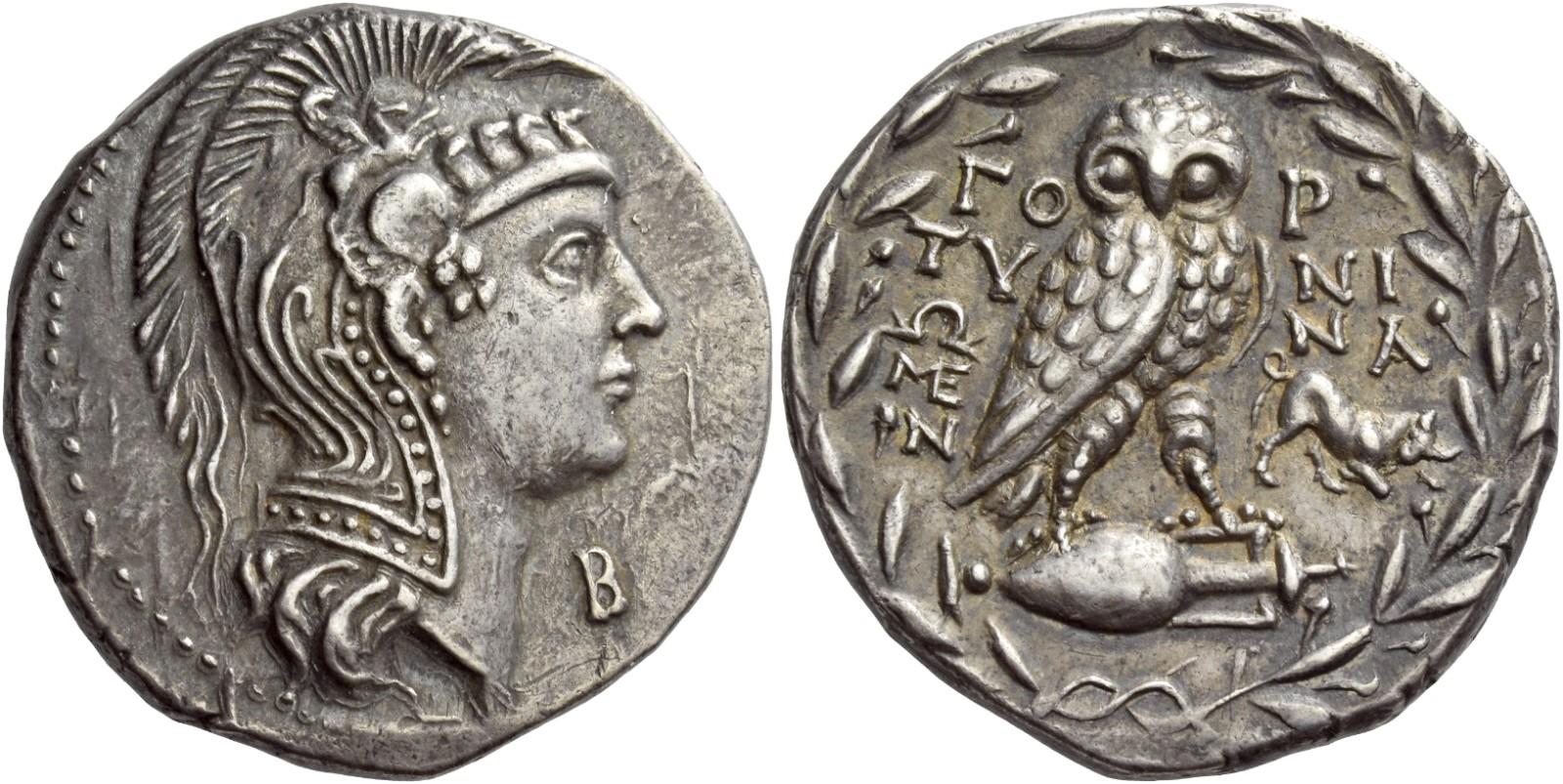Gortyn (Lucullus), silver, tetradrachms (Athena/owl) (87-86 BCE)
From SILVER
87 BCE - 86 BCE Silver 1,428 kg
Description
| ObverseInscription or printing placed on the obverse.: | Head of Athena Parthenos r., wearing triple-crested Attic helmet decorated with four foreparts of horses and a Pegasus, below, B |
| ReverseInscription or printing placed on the reverse.: | ΓO – P / TY – NI / Ω – N / ME – A / N (Greek).Owl standing r., head facing, on amphora, in r. field, bull butting r. All within olive wreath |
Mint and issuing power
| MintIdentifies the place of manufacture or issue of a numismatic object.: | Gortyn | Ancient regionAncient region.: | Crete | Modern countryModern country: Greece | AuthorityIdentifies the issuing power. The authority can be "pretended" when the name or the portrait of X is on the coin but he/she was not the issuing power. It can also be "uncertain" when there is no mention of X on the coin but he/she was the issuing power according to the historical sources: | Lucullus, Roman Republic |
Chronology
| FromIdentifies the initial date in a range assigned in a numismatic context. | 87 BCE | toIdentifies the final date in a range assigned in a numismatic context.. | 86 BCE | PeriodTime period of the numismatic object.: Hellenistic 323-30 BC |
Physical description
| MetalThe physical material (usually metal) from which an object is made.: | Silver |
Median weightMedian of the weights of numismatic objects (in grams). in grams | 15.90 | DenominationTerm indicating the value of a numismatic object. Examples: tetradrachm, chalkous, denarius.: | tetradrachm |
StandardStandard.: | Attic |
Image

S1737 Gortyna Lucullus.jpg [1]
References
| Die study referencePublication of the study: | |||
| Coin series referenceReference to coin series study: | Sear I1Sear I, n° 3183, RQEMH2RQEMH, n° 127 | ||
Obverse dies distribution
| FrequencyFrequency of specimen in distribution. ᵖ | Number of obversesNumber of obverse dies. ᵖ (o) | % (o) | Number of coinsNumber of coins. (n) | % (n) | Die nameName(s) of the die(s). |
| 2 | 2 | 50 | 4 | 21.05 | 2, 4 |
| 7 | 1 | 25 | 7 | 36.84 | 1 |
| 8 | 1 | 25 | 8 | 42.11 | 5 |
| Total | 4 of 4 | 100 | 19 of 19 | 100 |
Reverse dies distribution
no distribution is available
Quantification
| Number of obversesNumber of obverse dies. ᵖ (o) | 4 | Number of singletons (o1)The number of singleton coins. ᵖ | 2 |
| Number of reverse diesNumber of reverse dies. (r) | 7 | Number of coinsNumber of coins. (n) | 19 |
| Coins per obverse dieNumber of coins per obverse die. (n/o) | 4.75 | Coins per reverse dieNumber of coins per reverse die. (n/r) | 2.71 |
| Reverse per obverse ratioRatio of obverse dies divided by reverse dies. (r/o) | 1.75 | Percentage of singletons (o1)number of coins (n) divided by the number of singletons (o1) ᵖ | 50 % |
| Original number of dies (O) (Carter 1983 formula)The estimation of the number of coins according to Carter 1983 ᵖ | 4.49 | Coins struck if 20,000 as average productivity per dieCoins made if the average productivity for obverses (according to Carter) is 20,000. ᵖ | 89,800 |
| Original number of dies (O) (Esty 2011 formula)The estimation of the number of coins according to the singleton formula in Esty 2011 ᵖ (O) | 5.07 | Survival rate if 20,000 as average productivity per dieSurvival rate if average productivity is 20,000. ᵖ | 0.00021 |
| Coverage (o = % of O) (Esty 1984 formula)Esty 1984 - coverage (% of O) ᵖ (o = % of O) | 89.47% | Die productivity if survival rate 1/2,000Average productivity if survival rate is 1/2,000. ᵖ | 8,463.25 |
| Weight of silver (in kg) if 20,000 coins per die (O = Carter formula)Carter 1983 * Median weight * 20000 (*10 if gold or electrum) ᵖ | 1,428 kg <br /> 1,428 kg | Die productivity if survival rate 1/5,000Average productivity if survival rate is 1/5,000. ᵖ | 21,158.13 |
Remarks
Most likely one single workstation